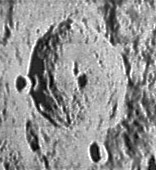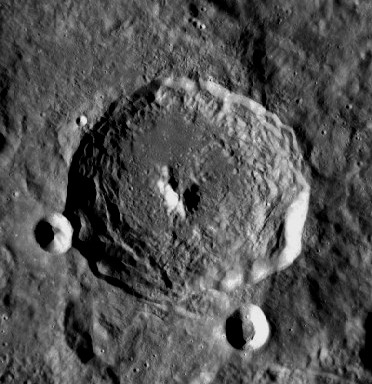Difference between revisions of "Plutarch"
| Line 14: | Line 14: | ||
<br /> | <br /> | ||
==Description: Elger== | ==Description: Elger== | ||
| − | ''([http://the-moon.us/wiki/IAU% | + | ''([http://the-moon.us/wiki/IAU%20directions IAU Directions])'' PLUTARCH.--A fine ring-plain E. of [http://the-moon.us/wiki/Oriani Oriani], with regular walls, and, according to Neison, with two central mountains, only one of which I have seen. Both this formation and [http://the-moon.us/wiki/Oriani Oriani] are beautifully shown in a photograph taken August 19, 1891, at the Lick Observatory, when the moon's age was 15 d. 10 hrs.<br /> <br /> |
==Description: Wikipedia== | ==Description: Wikipedia== | ||
[http://en.wikipedia.org/wiki/Plutarch_(crater) Plutarch]<br /> <br /> | [http://en.wikipedia.org/wiki/Plutarch_(crater) Plutarch]<br /> <br /> | ||
==Additional Information== | ==Additional Information== | ||
| − | * Depth data from [http://the-moon.us/wiki/Kurt%20Fisher% | + | * Depth data from [http://the-moon.us/wiki/Kurt%20Fisher%20Crater%20Depths Kurt Fisher database] |
** Westfall, 2000: 4.76 km | ** Westfall, 2000: 4.76 km | ||
** Cherrington, 1969: 2.8 km | ** Cherrington, 1969: 2.8 km | ||
Latest revision as of 02:09, 16 April 2018
Contents
Plutarch
|
Lat: 24.1°N, Long: 79.0°E, Diam: 68 km, Depth: 4.76 km, Rükl: 27, Eratosthenian |


left: LO-iv165-h3 . right: LROC
Images
LPOD Photo Gallery Lunar Orbiter Images Apollo Images
Maps
(LAC zone 45A3) USGS Digital Atlas PDF
Description
Description: Elger
(IAU Directions) PLUTARCH.--A fine ring-plain E. of Oriani, with regular walls, and, according to Neison, with two central mountains, only one of which I have seen. Both this formation and Oriani are beautifully shown in a photograph taken August 19, 1891, at the Lick Observatory, when the moon's age was 15 d. 10 hrs.
Description: Wikipedia
Additional Information
- Depth data from Kurt Fisher database
- Westfall, 2000: 4.76 km
- Cherrington, 1969: 2.8 km
- Central peak composition: A & GNTA1 (Tompkins & Pieters, 1999)
Nomenclature
- Named for Plutarch (c. A.D.46-c. 120), a Greek biographer. Among his miscellaneous writings is a partially surviving essay On the Face in the Moon, which discussed many hypotheses about the nature of the Moon based on its appearance to the naked eye, and introduced some of the earliest nomenclature for recognizable features.
- According to Whitaker (p. 201), the region around the modern Plutarch and Seneca was called Mons Alaunusby Hevelius.
- The names Plutarch and Seneca themselves derive from Riccioli, but there is some confusion over what features they were intended to be associated with.
- In Plate VIII of his book, Johann Schröter presents an image of a portion of the Moon as it appeared on March 29, 1789 at around 18:30 UT. Based on his interpretation of the nomenclature map of Tobias Mayer, the features he believes to be Plutarch and Seneca are clearly the modern Hahn and Berosus.
- Plutarch is listed as catalog entry 26 in Mary Blagg's Collated List (1913). Blagg believed that name had been used for the present feature by both Neison and Beer and Mädler, although Schmidt may have called it Timoleon. Schmidt's Plutarchus corresponded, according to Blagg, to the modern Seneca.
- Catalog entry 26 was assigned the name Plutarch in the original IAU nomenclature of Named Lunar Formations (1935). The name is there attributed to Riccioli, who called it Plutarchus (Whitaker, p. 214). It is also noted that Franz called this crater Oriani.
LPOD Articles
Bibliography